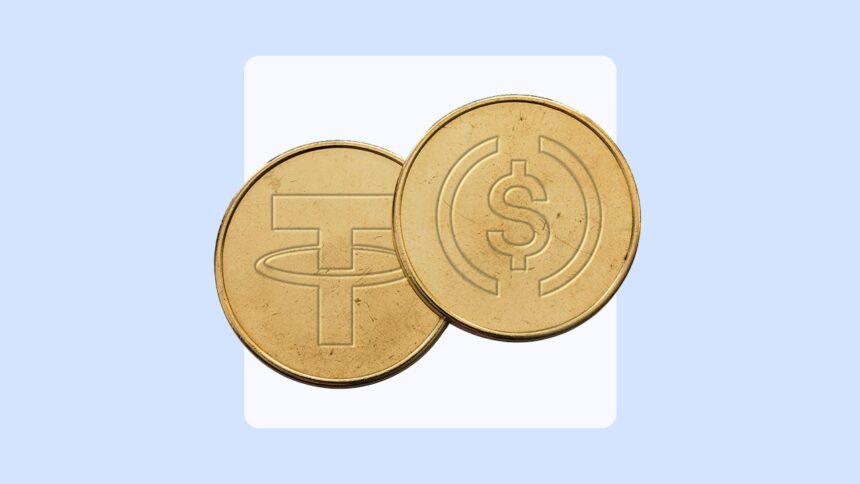
Images by Getty Images. Illustrations by bankrate
Stablecoins are a kind of cryptocurrency specially designed to maintain prices over time, usually pinned to US dollars. Tether (USDT) and USD Coin (USDC) are just two of the most popular types of stubcoin, but they differ in a few important ways.
Let’s take a look at how two cryptography stack up and what you need to know before investing.
USDT vs. USDC: How these stub coins stack up
These two coins may sound similar – they are both stablecoins, starting with the same first three letters – but there are some important differences they pay attention to, including how they allocate reserves and their approach to transparency.
This is a quick line-up showing how they differ. Data is from CoinMarketCap.com as of June 3, 2025.
| Important facts | Tether | USD coin |
|---|---|---|
| symbol | USDT | USDC |
| Year created | 2014 | 2018 |
| Market capitalization | $153.4 billion | $61.1 billion |
| Blockchain | multiple | Ethereum etc. |
| Owned | Private | Published |
| Audit Cycle | quarter | monthly |
Tether
Created in 2014, USDT is a Fiatback stub coin. This means that each token is equivalent to one dollar or cash. USDT is widely accepted and used in a wide range of blockchain types.
spare
Cash in favour of the token is held in the form of reserves and is managed by Tether Holdings Limited (USDT’s private, parent company). According to the latest March 31 preliminary report, Tether reported more assets than its liabilities, with $149.3 billion in reserves and about $143.7 billion in circulation coins.
Tether has quite a number of sanctuaries breakdowns. Most are US Treasury bills ($98.5 billion to be exact), overnight repurchase agreements, term reverse repurchase agreements, money market funds, cash/bank deposits, and other non-financial bills. However, Tether also has several alternative asset allocations, including secure loans, Bitcoin, precious metals, and corporate bonds.
Use Cases
Many investors use USDT tokens as a way to park their profits after selling crypto, avoiding the need to fully cash out of the crypto exchange. This avoids on-ramp and off-ramp fees. This is the fee you will be charged when you insert and remove Fiat Money from your crypto account.
Transparency
The token has previously faced several criticisms surrounding its transparency and support and accusations of market manipulation, with some experts even claiming that tethers are being used to raise the price of Bitcoin.
USDC
The USDC was created in 2018 and is also supported by the US dollar. It is managed by a company called Circle and runs on the Ethereum blockchain and is compatible with other blockchains such as Algorand, Stellar, Binance Smart Chain, and Hedera.
Circle has become a publicly available company because Crypto Exchange Coinbase holds fair shares. Circle and Coinbase were key players in the consortium that founded USDC.
spare
Unlike Tether’s quarterly reporting, Circle reports full reserves each month, but discloses reserve assets, mints and redemptions each week (Tether issues daily token updates). As of June 2, 2025, distribution had US$61 billion in USDC coins and $61.3 billion in reserves, according to Circle.
According to Circle’s 2025 State of the USDC Economy report, the USDC Reserve consists of almost 90% of the short-term US Treasury Department and overnight repurchase agreements. The rest is equivalent to cash or cash.
Use Cases
USDC offers the same benefits as Tether. For example, USDC acts as a valuable store, giving investors a place to park their cash rather than fully cashing out of the crypto.
Transparency
The real difference between the two tokens lies in the history of transparency that both companies show. USDC generally offers more transparency in terms of its reserves than tethers.
Things you need to know before purchasing USDT or USDC
These coins are designed to have less price fluctuations, but it is important to understand that you are still investing in the type of encryption and that the cryptography itself is very speculative.
And there are a few other drawbacks to keep in mind:
- There are no cash-generated returns: Cryptocurrency – in this case stablecoins – is not likely to have capital gains like inventory. Without trading cryptos regularly, your money might be a better response by investing in crypto ETFs or individual stocks rather than parking cash.
- It is not fdic-backed: Although the USDC and USDT may be supported by cash, the cash held in the reserve is not insured by the FDIC. Typically, FDIC will protect individual depositors up to $250,000 per account in the event of a bank failure, but this does not apply to Stablecoins.
- Removing the risk: Certainly, Stablecoins sees less price fluctuations, but the risk of losing the entire value is broader for several reasons. This can happen for several reasons, including liquidity, regulatory changes, and a major lack of market decline.
Conclusion
Stablecoins like USDT and USDC have eliminated some of the common challenges Crypto Investors face when they don’t want to completely cache out of crypto exchanges. However, each coin is different and stubcoin has some drawbacks to consider before investing.
Editorial Disclaimer: All investors are advised to conduct their own independent research into investment strategies before making an investment decision. Furthermore, investors recommend that past investment products performance is not a guarantee of future price increases.


